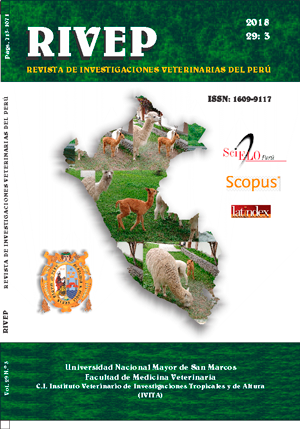Phytoplankton community of the Itaya river basin in Loreto, Peru
DOI:
https://doi.org/10.15381/rivep.v29i3.14766Keywords:
phytoplankton, composition, diversity, Itaya river, Peruvian AmazonAbstract
The phytoplankton community was evaluated in 21 samples collected in seven sites in the Itaya river basin. In total, 70 species belonging to 40 genera, 21 families and 6 divisions were identified. The most abundant group was Bacillariophytas (51%), followed by Chlorophytas (31%), Euglenophytas (11%), Cyanophytas (5%), and others (2%) corresponding to Xanthophyta and Chrysophyta. The best represented species were Surirella ovalis, Navicula sp and Pinnularia sp. For this ecosystem, the density was between 100 to 13 000 ind/l-1 (individuals per litre) out of a total of 24 500 ind/l-1, with a richness of 11 to 27 species and an abundance of 23 to 55 individuals. The analysis of diversity according to Shannon-Wiener was from 7.26 to 25 units of effective species, with an equity of Pielou of 0.84-0.97, which indicates that the populations were homogeneous. Regarding the similarity index, it shows that the phytoplankton communities were formed by three groups with a similarity of 35%. According to the diatomic index (IDG), it is concluded that the water of the Itaya river could be contaminated at the sampling points.Downloads
Downloads
Published
Issue
Section
License
Copyright (c) 2018 Rosa Ismiño, Grace Montalván, Aurea García, José Maco, Salvador Tello, Juan José Palacios, Luciano Rodríguez

This work is licensed under a Creative Commons Attribution-NonCommercial-ShareAlike 4.0 International License.
AUTHORS RETAIN THEIR RIGHTS:
a. Authors retain their trade mark rights and patent, and also on any process or procedure described in the article.
b. Authors retain their right to share, copy, distribute, perform and publicly communicate their article (eg, to place their article in an institutional repository or publish it in a book), with an acknowledgment of its initial publication in the Revista de Investigaciones Veterinarias del Perú (RIVEP).
c. Authors retain theirs right to make a subsequent publication of their work, to use the article or any part thereof (eg a compilation of his papers, lecture notes, thesis, or a book), always indicating the source of publication (the originator of the work, journal, volume, number and date).










